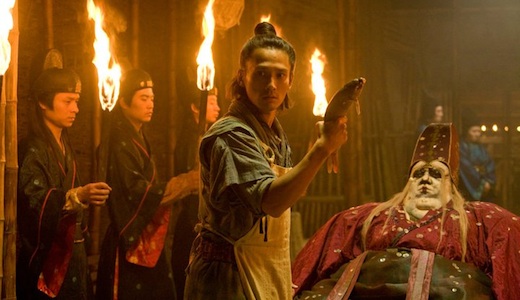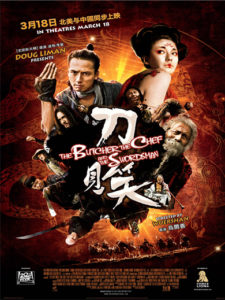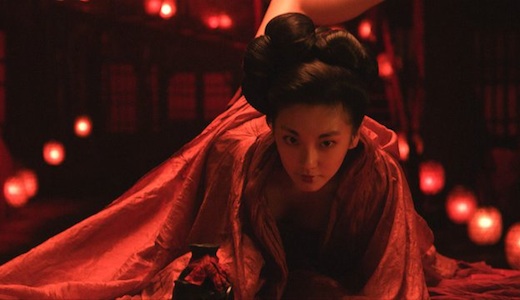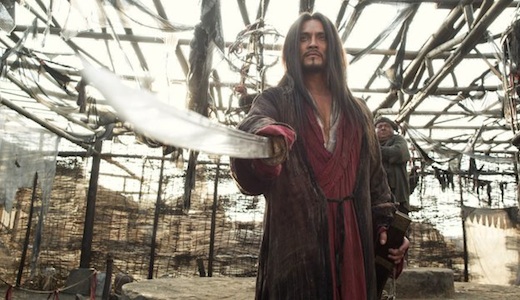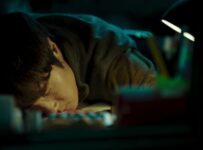Wuershan’s debut feature is a ballsy one, taking an everything-including-the-kitchen-sink approach to storytelling. Combining familiar archetypes with distinctive visuals, and marks the arrival of a new era of Chinese filmmaking and a bold new voice.
It often seems that in order for the West to be widely exposed to films that have subtitles, they are usually released on DVD or Blu-ray, remade in English or in rarer cases, they have the backing of a major Hollywood studio or director. In the case of successful commercial director Wuershan’s debut feature, based on An Changhe’s short story “The Legend of the Kitchen Knife”, the major studio is Fox International and Doug Liman (Fair Game) takes a leaf out of Martin Scorsese and Quentin Tarantino’s book in presenting it simultaneously to Chinese and English-language audiences.
The Butcher, The Chef and the Swordsman (刀见笑 or Dao Jian Xiao) is made up of three stories. ‘Desire’ concentrates on Chopper the Butcher (Liu Xiaoye), a low-class meat-merchant who falls head over heels in love with courtesan Madame Mei (Kitty Zhang, CJ7) after a random encounter. In ‘Vengeance’, a mute kitchen hand (Ando Masanobu, Sukiyaki Western Django) may be the only hope for a famous restaurant when the notorious Eunuch Liu, known for dispatching those who displease him, comes to pay a visit. Finally, in ‘Greed’ we follow swordman Dugo Cheng (Ashton Xu) who seeks out master sword-maker Fat Tang (You Benchang) in the hopes of crafting a weapon that will make him unbeatable.
Wuershan’s film is the kind of visual assault on the senses that might be handily dismissed as a ‘comic book style’ were it not for its completely unique look and feel. While the freaked-out fashion of the movie may be more common in the hyperkinetic hybrid movies that have been popular in Hong Kong and Japan in recent decades, from the likes of Takashi Miike (particularly Sukiyaki Western Django) or Stephen Chow (Kung Fu Hustle), this is certainly one of the most enthusiastically different films to come out of mainland China in some time. The film uses a mixture of 8mm film stock, black and white photography and even animation (in a key flashback sequence) to create a distinctive amalgam of influences that perhaps only Wuershan could identify.
Restraint is not something that Wuershan does well here, defying one of his own character’s pieces of advice to “be pragmatic”. Over the top swordplay, cooking montages, musical sequences, impossibly large eunuchs and the scariest beard you’ll ever see are just some of the over the top elements found in The Butcher, The Chef and the Swordsman. Any single one of these elements would be enough to tip the film over the edge into silliness, but there is something intangible about the combination of all of them at once that creates a perfect storm of chaos, comedy and anachronistic madness. Later in the film, the rather well-worn use of a Street Fighter-esque video game reference is counterbalanced by the use of a Korean-style news graphic showing a cross-section of a horse’s unfortunate encounter with a sword.
The Butcher, The Chef and the Swordsman suffers from a lack of consistency at times, and the slapstick humour is of the basest kind. Yet the winning combination of graphics, action, music video aesthetics and even flat-out musical sequences all makes for something unique and more importantly, fun. The chaotic vision of a highly commercial director may not appeal to all audiences, but the sheer amount of boldness and innovation poured into every frame is demonstrative of the gap between cookie-cutter Hollywood action films and the inventive experimental attitudes of our Chinese brethren.
The Butcher, The Chef and the Swordsman was released in Australia on 17 March 2010 by China Lion Entertainment.

